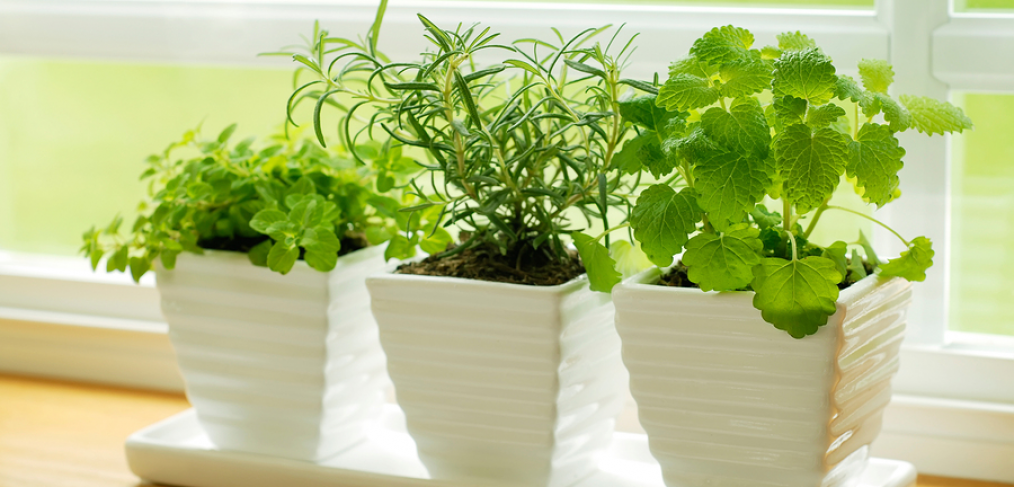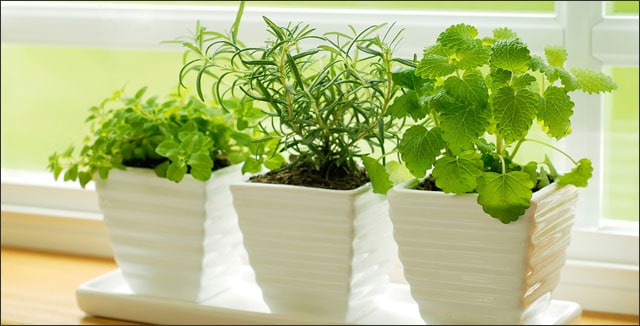
Indoor Herb Gardens: How to Get Growing and Cooking

If you are an avid gardener, or an avid cook, you may know that the secret to creating the most flavorful dishes lies in fresh ingredients. You know that salad tastes best when it was growing in the dirt half an hour ago and sun-ripened tomatoes have no store-bought match for taste and consistency.
Winter can be long for a gardener in colder climates. One remedy for this, and for the comparative blandness of our food in the winter months, is to grow a fresh herb garden indoors. It can have a wonderful, lifting effect on your mood as well, as you see and smell your green plants day after day.
Finding a Spot
Depending on your house, you may have the ideal spot for growing potted herbs or it might be a challenge. The best possible thing would be to have a south-facing kitchen window-sill deep enough to house a line of little pots, but not everyone has been gifted such a thing.
Regardless, herbs need at least four hours of sun daily so you need to choose a south, southwest, west or west facing window. Northern windows won’t ever offer enough sun. Do a test one day: turn off all your lights and periodically check which areas of your house are brightest. Maybe your kitchen isn’t the best place, but herbs can still brighten a living, dining or bedroom.
If you have a sunny kitchen window with no sill, check into some hanging options. Herb pots don’t have to be huge and heavy. You could hang several on the sides of your cupboards or on some hooks suspended on a pole across the front of your window.
In addition, I have seen clever tricks with a drilled-out PVC pipe suspended across the bottom ledge. There are also plenty of ready-made hanging gardens for those of you who don’t DIY. For those of you who do: I’ve seen an easy DIY self-watering system made with a couple of wine bottles and some string.
Choosing Varieties for Indoor Herb Gardens
It’s helpful to know which herbs are easy to grow indoors and which are finicky. I like a challenge, but it can be frustrating to keep killing plants and having to start again.
The three hardest, unfortunately, are basil, cilantro, and sage, but never fear. It’s not impossible. Try looking for Spicy Globe or African Blue variety basil – they work better indoors, and make sure you keep it away from drafty windows! Basil is very sensitive to temperature. Try planting coriander seeds in a blanket in a shallow flat tray and harvest them roots and all when they get about five inches tall. Dwarf sage is more compact and easier to grow indoors. Remember that it’s very susceptible to mildew and over-watering.
Speaking of which, all of your herbs need good drainage. This shouldn’t be a surprise for any gardener, but if you’re trying this out for the first time, be aware that you need a pot with a drainage hole (and a pan underneath to shield your surface from water) and good-quality soil made for indoor plants that doesn’t clump when you grab a pinch of it. When it gets wet it should remain loose.
Oregano, rosemary, and thyme are easier to grow than the first three, but still not the easiest. The Greek variety of oregano may be your best bet. Make sure it gets a lot of light. Rosemary does best on the dry side. Tuscan Blue or Blue Spire may work best, and you might want to look into supplemental light. Don’t over-water. Thyme, as well, may need supplemental light.
Here’s a list of some of the easiest herbs to grow:
- Bay Tree (Laurus nobilis – best for cooking)
- Chive (Grolau variety)
- Kaffir Lime Tree (needs special citrus food)
- Lemongrass (requires no soil, just use a stalk you buy at the grocery store and keep in a container with a couple inches of water. It will send out roots and new sprouts and stalks from the bottom. Just make sure it has the bottom intact and a good amount of stem)
- Mint (Be aware! It’s invasive)
- Parsley
- Vietnamese Coriander (very reliable and almost identical in taste to cilantro)
- Lemon Balm
- Marjoram
Caring For Indoor Herb Gardens
The most basic thing you need to remember is that herbs need a lot of sun. They also need consistent watering. Indoor winter spaces tend to be very dry and if you have them in clay pots so they can breathe, you need to buy a humidifier or give them a little bath once a week.
Beyond that, herbs need to be fed. Find an herb fertilizer or fish emulsion (or make your own!) or liquid seaweed. If those sound stinky, they are. Find a fertilizer that has a low level of phosphorous so it doesn’t promote blooming.
One suggestion is to pre-make the water you’ll use to water your herbs in a gallon jug and adding a tablespoon of fish emulsion to make a very weak organic fertilizer solution which your herbs will then get every time you water them. Your plants should otherwise tell you when they need to be fed: they will stop growing.
Biggest Downfall
Over-watering can be your biggest downfall. Learn to read what the plants need. Let them dry out completely before watering and then check the root system so you get a sense of how long it takes them to dry out completely. Over-watering leads to rotting roots, which can’t take in the moisture they need.
Water the base where the stem meets the dirt and not the leaves, letting the water soak through, then soak the plants again. Let the water drain completely before replacing on their saucers. If they sit all day in a puddle, it’s a recipe for rotting. Yellow leaves are a good indication of over watering.
Additionally, herbs need room. For individual herbs use pots no smaller than 6 inches in diameter. I suggest buying plant starts, or baby plants. It’s hard to grow things from seeds. Also, very important, buy a plant that’s never been planted outside. That transition can be too traumatic for the plant. Your best bet is to buy locally – then you will get plants that are acclimated to your area.
Last, but not least: cut your herbs often (that’s what they’re for, after all), but not more than ⅓ of the plant.
Take Away
In conclusion, try your hand at kitchen gardening inside this winter! Your taste buds will thank you.
You might also like to read:



